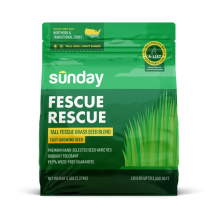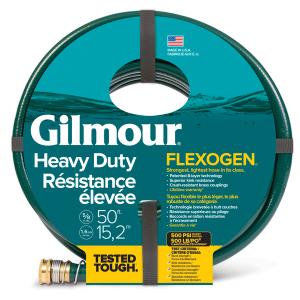Is tall fescue right for my lawn?
Tall fescue grows from the mid-south and up. As a cool-season grass, it thrives in cooler environments, though it can withstand heat better than other cool-season grasses. Tall fescue can be grown in a variety of soil types and typically requires less maintenance than other cool-season grass lawns. It is also easier to contain than some other species and will not overtake flower beds and other landscaped areas. Because it tends to grow in clumps, it typically needs to be re-seeded each fall, especially important when the lawn has thinned due to summer heat stress.

Fescue Rescue Grass Seed
- Drought tolerant
- Medium sunshine and water
- 99.9% weed-free guarantee
- For northern, transitional climates

Pet Lawn Grass Seed
- Proven dog spot resistance
- One five-pound bag can overseed up to 2,500 square feet
- One five-pound bag can seed 1,250 square feet of new lawn
- For happy lawns and happy paws!
Establishing a tall fescue lawn
Keeping the upper 1 to 2 inches of soil moist (but not wet) after seeding assists germination, which should occur within 12 days. For best results, a soil test should be conducted prior to planting the lawn to determine nutrient and liming needs. If the soil test results call for nutrient supplementation, starter fertilizer should be incorporated 3” to 4” into the soil. In addition, tall fescue prefers soils in the pH range of 5.5 and 7.5, and liming may be recommended before planting based upon the soil test results.
Tall fescue can be seeded or sodded. Like other cool-season grasses, tall fescue is best seeded in the late summer or early fall as spring seedings are prone to weed infestations and stress from summer drought. Sod can generally be installed throughout the year, except when the ground is frozen in winter or in the summer when extreme heat or drought is a potential issue.
New lawns have a greater irrigation need than established lawns and therefore it is important to irrigate frequently and lightly until a viable root system takes hold. Keeping the upper 1 to 2 inches of soil moist (but not wet) after seeding assists germination, which should occur in 5 to 10 days. Once the seedlings are established, the frequency of watering can be reduced, but should wet the soil to a greater depth.
Caring for your tall fescue lawn
Fertilization
Tall fescue has relatively low nutrient level requirements. Leaving grass clippings can help to meet some of the lawn’s fertilization needs, unless the clippings are too thick, in which case they should be collected and composted elsewhere.
Mowing
Tall fescue is typically maintained at a height of 2” to 3”. In the hottest months, the lawn can be maintained at a somewhat taller height ( 3” – 4”), but should not be allowed to grow too tall (5” or greater).
Watering
Tall fescue requires deep and infrequent watering, using moderate or greater amounts of water. Dark bluish-gray grass and wilted, folded, or curled leaves can be used as a visual indication that the grass needs water, which should be applied in sufficient quantity to wet the soil to a depth of 4” to 6”. If the lawn is allowed to go dormant during the hottest months, it should be watered at least every 3 weeks to keep the lawn alive until cooler weather arrives.
Pests
White grubs, sod webworms, cutworms and armyworms can destroy plantings of tall fescue. Monitoring for these species should be conducted in order to address the issue before lawn damage occurs.
Diseases
Tall fescue is highly susceptible to brown patches during summer conditions of high temperatures (above 85°F) and high humidity. Brown patch outbreaks can become severe when prolonged overcast weather and high nighttime temperatures prevail.
Weeds
Heat stress during the summer months can thin the canopy of a tall fescue lawn. Openings in the lawn caused by this thinning make tall fescue lawns more susceptible to summer weeds, such as crabgrass.
Let's get growing
We use climate science and soil data to create a custom plan just for your yard, so it gets exactly what it needs. Nothing more, nothing less.



















